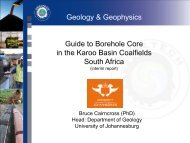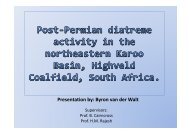coaltech upper olifants river catchment wetland inventory ...
coaltech upper olifants river catchment wetland inventory ...
coaltech upper olifants river catchment wetland inventory ...
You also want an ePaper? Increase the reach of your titles
YUMPU automatically turns print PDFs into web optimized ePapers that Google loves.
One of the reptile species, the Striped Harlequin Snake (Homoroselaps dorsalis) is included<br />
in the Gauteng Department of Agriculture, Conservation and Environment (GDACE) species<br />
list of species of concern. The species prefers grassland as its habitat and is therefore not<br />
<strong>wetland</strong> dependant (Branch 1998). The <strong>wetland</strong>s may, however serve as refugia for the<br />
species, especially the drier/temporary <strong>wetland</strong>s. A number of additional reptile species are<br />
protected under the Nature Conservation Ordinances and are included as species of<br />
concern.<br />
3.3.4 Amphibians<br />
A wide variety of frog species utilise <strong>wetland</strong>s in the UORC. Of the 23 frog species that have<br />
been observed in the UORC and the five species from adjacent areas, 26 are <strong>wetland</strong><br />
dependant. Pyxicephalus adspersus (Giant Bullfrog), a Near Threatened species is the only<br />
species of concern observed in the UORC (Bryan Maritz pers com 2005). The Giant Bullfrog<br />
occurs in a variety of vegetation types including the Grassland, Savanna, Nama Karoo and<br />
Thicket biomes. They breed in seasonal, grassy, shallow pans, but can also utilise non-<br />
permanent vleis, as well as shallow water next to waterholes and dams. These vleis and<br />
dams occur in flat open areas. They prefer sandy substrates, but sometimes utilises clay<br />
soils (Minter et al 2004).<br />
3.3.5 Invertebrates<br />
Existing data studied by Palmer et al (2002) indicated that the aquatic invertebrates found in<br />
the UORC consist mostly of common, widespread taxa. The abundance and productivity of<br />
these taxa are important to maintain higher trophic levels, most notably birds. The local<br />
variation in the species composition is also high, probably due to local variation in habitat.<br />
Although most insect species have good dispersal abilities, their ability to disperse into<br />
disturbed areas is dependant on the availability of natural refugia. Most of the crustacea and<br />
snail species are adapted to temporary dry conditions, whereas some other species depend<br />
on areas that are permanently wet. Dams and weirs therefore favour species dependant on<br />
permanent wet conditions and lowers the diversity, and species numbers adapted to<br />
temporary dry conditions. It is therefore necessary to maintain a mosaic of temporary,<br />
seasonal and permanently wet systems in order to support the wide variety of aquatic<br />
invertebrates potentially utilising the <strong>wetland</strong>s in the <strong>catchment</strong> (Palmer et al 2002, CSIR<br />
2001).<br />
Wetland Database for UORC - 26 -




